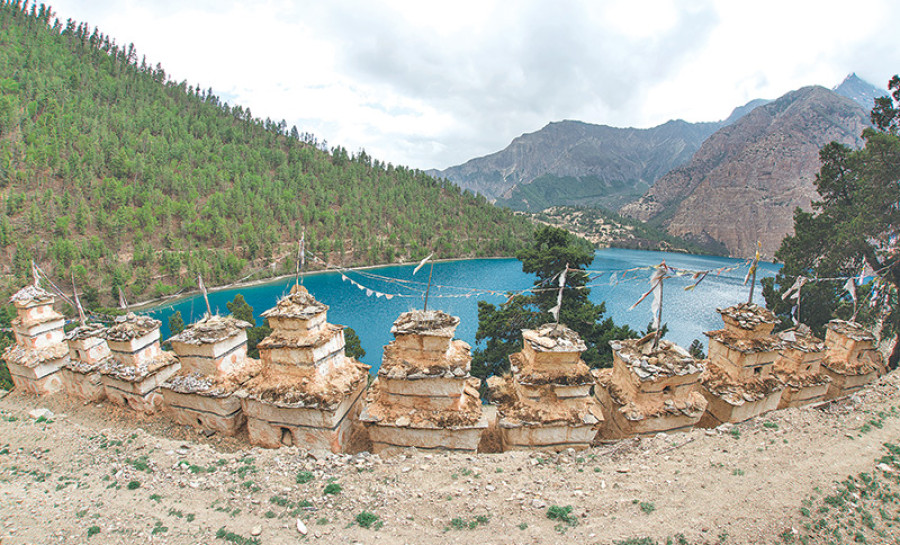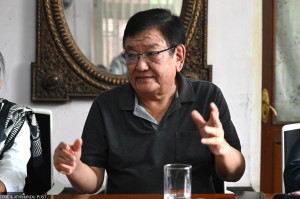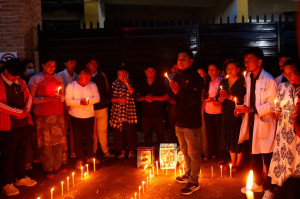Miscellaneous
Nepal as a Dharma destination
Near the foothills of Chandragiri, in a spacious front yard, German national Hannah Wiggenhauser is busy memorising mantras for a shamanic ritual.
Sandesh Ghimire
Near the foothills of Chandragiri, in a spacious front yard, German national Hannah Wiggenhauser is busy memorising mantras for a shamanic ritual. Every time she struggles, Subin Rai, a dhami, translates the chants into a language that is easy for her to internalise, “Both the physicist and the shaman believe that appearances are illusory. The physicist studies atoms in order to understand reality, while we are trained to experience it directly.”
The environment is relaxed; Subin is casually dressed and there are about half a dozen dogs lounging in the sun. From the yard, you can hear somebody practicing the dhyangro, a ritualistic drum.
At the entrance of the house, a board indicates that this spacious property is the Shamanistic Studies and Research Centre. Hannah was in Sri Lanka visiting various Buddhist shrines before she came to the Centre with her husband for a 10-day course in Himalayan Shamanism, but she has been here for almost a month.
A few years ago Hannah says she was “seeking spiritual fulfillment in life,” and found herself attending a small workshop led by Mohan Rai, the founder of the Centre, in the city of Ulm in Germany. “After that, I read Mohan’s biography and I was drawn here.”
In the eighties, Mohan, a trekking guide, began including a shamanic ritual to enhance his tour packages.
On these trips, he found that many tourists seemed curious and often wanted to learn about Shamanism in Nepal. This became the inspiration for the eventual founding of the Shamanistic Studies and Research Centre in 1988. As the founding instructor, Mohan participated in several spiritual conferences and workshops in America and Europe.
During his travels, Mohan was able to capture the imagination of hundreds of people, and many, like Hannah, came to Nepal to experience the practice of shamanism first hand. After Mohan passed away in 2015, Subin, his son, and other members of the family have been making an effort to continue the family tradition. Over the course of two decades, the Shamanistic Institute has drawn in about 3000 students, mostly from Europe and the US.

“Going on a pilgrimage was, historically, the first form of spiritual tourism,” says Deepak Raj Joshi, CEO of Nepal Tourism Board (NTB), speaking about spiritual, or Dharma, tourism in Nepal, “And given Nepal’s image in the western world, many come to Nepal on spiritual, as much as physical, journeys.”
The image that Joshi is referring to is described in the Mark Lietchy’s new book, Far Out: Countercultural Seekers and the Tourist Encounter in Nepal, as the predisposition in the west to equate Nepal “to dreams of Shangri-la” where people come to “discover” what they already perceived to be here.
These tourists are “desperate to inject meaning in lives,” and Nepal has cashed in on that longing by rebranding itself as an adventure and spiritual destination. Over the years, “Dharma tourism”, as Lietchy puts it, has boomed in Nepal, and according to a report published by NTB, in 2016, 82,830 people stated during immigration that they came to Nepal for a ‘spiritual reason’. Joshi estimates that the number will increase by 12 percent in 2017.
Tourism, thus, Joshi says, can help promote and preserve traditional practices like shamanism which are endangered by modernisation. But to do so, must traditions evolve and expand themselves in order to become accessible to those who come seeking it?
“The problem is, of course, that what tourists come looking for is often more a reflection of their home society and its concerns, than of Nepal’s,” Liechty writes in an email correspondence with The Post. “It is an incomplete, romanticised version of Nepal, not the Nepal that Nepalis experience on a daily basis. Thus the required transformation in cultural practices might be more difficult for Nepalis than for the tourists seeking it.”

Yet, when a balance is found, the result can be beneficial to both the tourists who are seeking spiritual experiences and Nepalis who derive a living by giving continuation to traditional practices, according to Subin.
He and other practitioners at the institute make regular trips to Europe to conduct retreats on shamanic practices in Nepal, which in turn helps draw students to Nepal. The Shamanistic Centre is one of many organisations who have reoriented age-old traditions in order to make them accessible and appealing for those who come seeking it.
Hannah shares that she was struggling with general well-being for a number of years, but after studying and partaking in various rituals at the Centre for a month, she feels more aligned with herself. “What is truly amazing about the practice is the connection you feel with nature. In the west we have started to think of ourselves as the product of our own actions, independent of the nature we live in, but being here has been a reminder about the inherent interconnectedness of life.”
Along with Hannah, Angelica Nedelseder, from Austria, is currently enrolled at the institute as a long term student. “I think there is a lot of materialism in Europe,” she says, “Coming here, simply living with a large family and playing the dhyangro, I feel that I am getting in touch with the undercurrents that guide our lives.”
But adapting to global expectations comes at the cost of giving up on a degree of coherence and understanding enjoyed by the community of original practitioners. According to the scholarly book Shamanism and Tantra in the Himalayas by Claudia Muller-Ebeling, Christian Ratsch, and Surendra Bahadur Shahi, shamanism is a complex medium used to access the world of consciousness which is not readily available to our senses.
In order to think of the world as a “motion of consciousness”, shamans have developed an intricate world view and stories. However, many of these historical underpinnings of shamansim–its myths and stories–are lost, when Subin describes his practice to his students as a way of “maintaining balance between forces of nature and the society.”
These simplified explanations, according to Subin, keeps Hannah’s and Angelica’s interest in eastern religion alive and relevant. Nonetheless, as Liechty puts it “whoever sells the ‘product’ (shamanism) to the tourist is inevitably going to objectify and even disenchant the whole worldview on which it is based.”
The alternative, of keeping the practice within the community to preserve the original values, however, can be a lose-lose situation. “The shamanic tradition is on the wane, and it is highlighted by the dearth of young shamans taking to the practice,” Subin says, “There are still handful of locals left who come to seek treatment from shamans, but the same people believe and mistrust us for the same reason.
They come to us out of the fear of the unknown, not because of faith in our healing power. However, there is a greater population that dismisses shamanism as a superstitious practice—the tradition is slowly losing its traction and validity in Nepal. I am not certain if my seven year old daughter will grow up to continue the practice.”
“Time corrodes many cultural practices, and several traditional practices have been lost to modernisation,” Joshi says, “but if there is an economic incentive, then people will be interested to preserve their heritage. Obvious examples like the Tharu dance, and several Newar and Sherpa traditions, show how parts of Nepali culture have been preserved because there is a continued outside interest.”
The criticism of Western society and ideals, which intensified after the Second World War, as Lietchy points out in his book, set westerners in search of new experiences in “exotic far-away places”. Spiritual seeker, or experiential tourists—as travel entrepreneurs call them—“is growing exponentially around the world. The boom in yoga and meditation as healing practices in the west proves that there is an intense desire among westerners to incorporate non-western traditions,” Joshi says, “While countries like Peru are bringing in millions of experiential tourists every year, Nepal is only experiencing a trickledown effect of the global phenomenon.”
To tap into the pool of potential guests, Joshi informed that NTB is spending 550 million rupees to aggressively promote Nepal’s adventure and spiritual potential to the world. The promotion might bring the desired number of tourists, but at a time when Nepal is adopting western development ideals, one wonders how Nepal will retain the historical western perception of being the “geographical emblem of anti-structure.”
Lietchy explains in his book that “when Nepali entrepreneurs finally realized the economic potential of tourism, and its symbolic underpinnings, they grabbed the fantasies that tourists brought with them, and skillfully sold tourists what they had come looking for.” The coming of age of Nepali tourism, he says, is also “its loss of innocence.”
Lietchy implicitly points out the irony of selling an enchanted spiritual world view that Nepalis themselves are becoming disenchanted with, but this “drama of twentieth-century global modernity” must go on because prosperity of Nepal’s economy depends on the delicate packaging of Nepal’s travel entrepreneurs.
“For me and my family, shamanism is not only a source of income, but a way of life,” Subin says, “We are drawing plans to establish a living museum, which we hope will attract young Nepalis to learn shamanistic practices.”
If there were more young Nepali shamans, Subin argues, there will be people like Hannah who will initially come for a short duration, but will decide to elongate their stay.
The trick is to get tourists to find aspects in spiritual learning that echo of home for them, according to Lietchy. Tibetan Buddhism has been able to create a global following, and in Nepal, the Kapan Monastery is but one example of organisations that have successfully managed to hold the interest of tourists who come to be transformed.
Having understood this, Subin has learned the art of harnessing the curiosity of his students. “What science is telling us today is something, Vedas have been saying for three thousand years,” Subin says to Hannah as a way of concluding his lesson for the day.




 25.12°C Kathmandu
25.12°C Kathmandu










